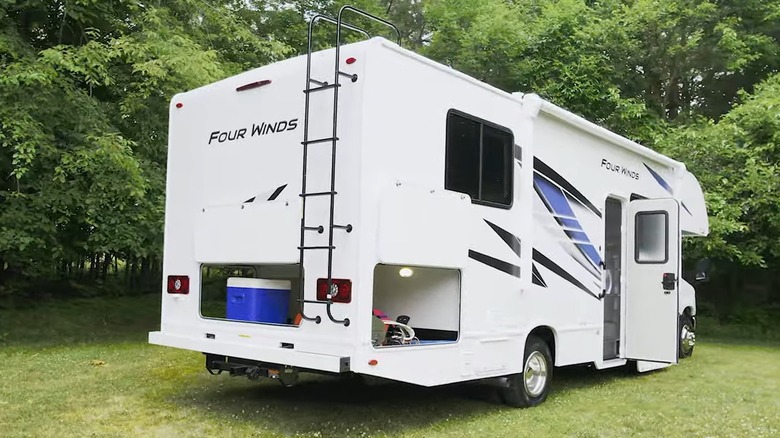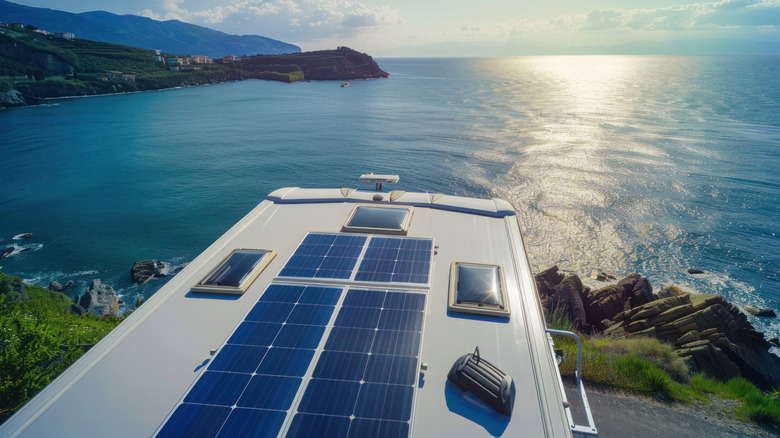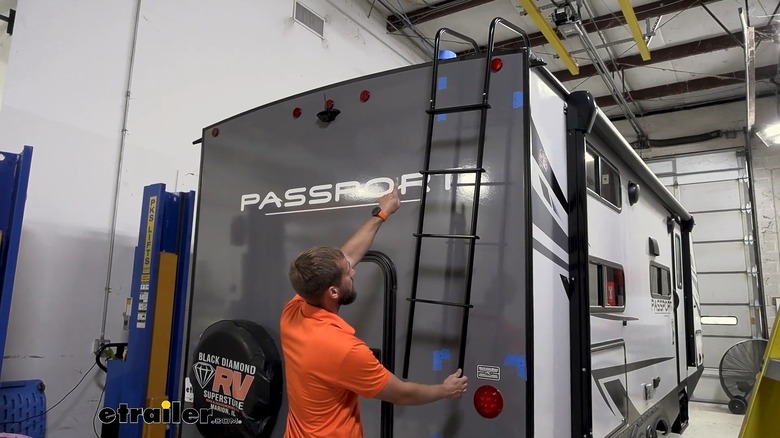Why Do RVs Have Ladders To The Roof? Here's What They're For
We may receive a commission on purchases made from links.
If you've taken a road trip lately, you've likely noticed the highway populated with a steady flow of recreational vehicles. If you rode behind a travel trailer or motorhome, you might have spotted a ladder in back going up to the roof. This ladder provides owners an easy way to check and work on components like air conditioning units, antennae, and fans. Some RVs have rooftop storage; ladders also make accessing that space possible. In addition, considering that the size of these vehicles prevents a run through the average car wash, perching up there makes cleaning easier.
Those harnessing the sun for extra power also need access to periodically clean that eqipment, and here are a few other things to know before installing solar panels on your RV roof. RV roofs can be made from synthetic rubber membranes layered over a plywood structure, solid metal like the iconic Airstream trailers, or fiberglass. Before you decide to climb on top of your RV, you should be familiar with which type you have in order to prevent damage or injury.
Am I safe up there?
An RV roof is a dangerous place and can put you more than 13 feet off the ground. You have to carefully avoid falling or stepping on skylights or vents which aren't designed to bear weight. The first step before climbing up there should be to consult your owner's manual, as it should state whether the roof was designed to be walked on. Many RVs may not even have a ladder to the top, to avoid customers climbing up and getting hurt.
Even if it's strong enough to support you, it's possible to cause damage to the roof. Some camper vans are similar in structure to a car. As you can imagine, walking across the roof of your car might create large dents, as the sheet metal isn't designed to support much weight. For example, these retro RV campers look just like a classic VW Bus. While they're cool-looking, you probably shouldn't venture onto the roof.
If your RV came with a factory installed ladder this probably means the roof is walkable, although it's always a good idea to verify this with your owner's manual or dealership representative. If you're unsure about your RV's capacity to handle someone on the roof, you can always perform maintenance with a sturdy ladder placed on the ground beside the vehicle.
Can you add a ladder to an RV without one?
In some cases, it's possible to add a rear ladder, however there are a few critical factors to keep in mind. Some RVs include a rear window in the design. These windows aren't just for natural light or backcountry views, but also serve as an emergency exit. Installing a ladder over or around this window could potentially block egress in the event of an accident or fire. Its not just rear windows that may be an issue for an aftermarket ladder install; the Vario Perfect Platinum features a rear hatch large enough to transport a car and is one of the coolest camping RVs ever built.
Another consideration when adding a rear ladder to your RV is how to mount it. When the manufacturer includes a ladder in its camper design, the factory is well aware of which areas are best for attaching load-bearing add-ons to the vehicle's frame. However, unless you can get your hands on model-specific build diagrams which highlight your RVs internal structure, it will be a challenge to know where to safely attach the ladder. A safer course of action may be to opt for something like the SocTone 12.5-foot telescoping ladder. This will allow you to access roof areas of your RV, then collapse it into a compact form for easy onboard storage.


